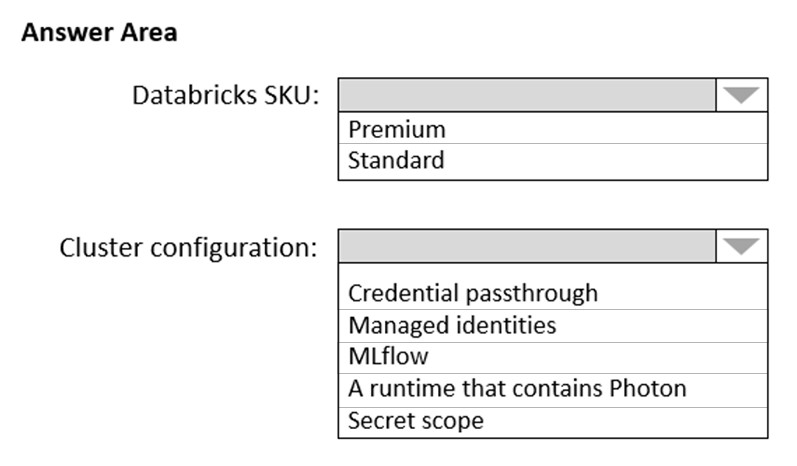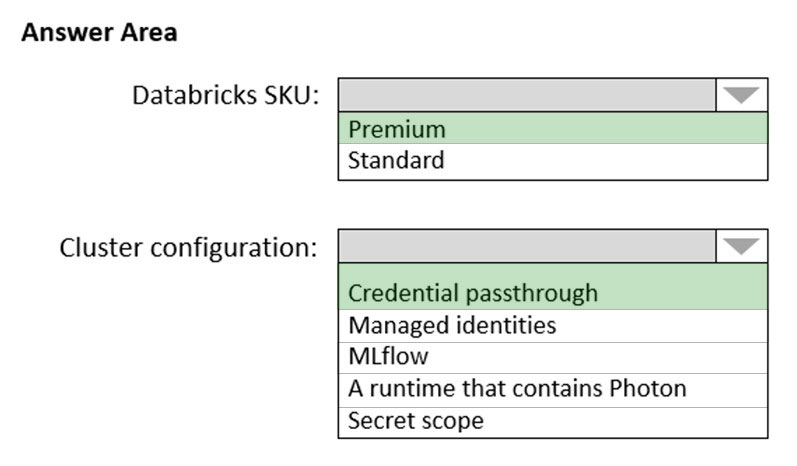You have an Azure subscription that contains a custom application named Application1. Application1 was developed by an external company named Fabrikam,
Ltd. Developers at Fabrikam were assigned role-based access control (RBAC) permissions to the Application1 components. All users are licensed for the
Microsoft 365 E5 plan.
You need to recommend a solution to verify whether the Fabrikam developers still require permissions to Application1. The solution must meet the following requirements:
✑ To the manager of the developers, send a monthly email message that lists the access permissions to Application1.
✑ If the manager does not verify an access permission, automatically revoke that permission.
✑ Minimize development effort.
What should you recommend?
Answer:
A
Reference:
https://docs.microsoft.com/en-us/azure/active-directory/governance/manage-user-access-with-access-reviews
You have an Azure subscription. The subscription has a blob container that contains multiple blobs.
Ten users in the finance department of your company plan to access the blobs during the month of April.
You need to recommend a solution to enable access to the blobs during the month of April only.
Which security solution should you include in the recommendation?
Answer:
A
Shared Access Signatures (SAS) allows for limited-time fine grained access control to resources. So you can generate URL, specify duration (for month of April) and disseminate URL to 10 team members. On May 1, the SAS token is automatically invalidated, denying team members continued access.
Reference:
https://docs.microsoft.com/en-us/azure/storage/common/storage-sas-overview
You have an Azure Active Directory (Azure AD) tenant that syncs with an on-premises Active Directory domain.
You have an internal web app named WebApp1 that is hosted on-premises. WebApp1 uses Integrated Windows authentication.
Some users work remotely and do NOT have VPN access to the on-premises network.
You need to provide the remote users with single sign-on (SSO) access to WebApp1.
Which two features should you include in the solution? Each correct answer presents part of the solution.
NOTE: Each correct selection is worth one point.
Answer:
AE
A: Application Proxy is a feature of Azure AD that enables users to access on-premises web applications from a remote client. Application Proxy includes both the
Application Proxy service which runs in the cloud, and the Application Proxy connector which runs on an on-premises server.
You can configure single sign-on to an Application Proxy application.
E: Add an on-premises app to Azure AD
Now that you've prepared your environment and installed a connector, you're ready to add on-premises applications to Azure AD.
1. Sign in as an administrator in the Azure portal.
2. In the left navigation panel, select Azure Active Directory.
3. Select Enterprise applications, and then select New application.
4. Select Add an on-premises application button which appears about halfway down the page in the On-premises applications section. Alternatively, you can select Create your own application at the top of the page and then select Configure Application Proxy for secure remote access to an on-premise application.
5. In the Add your own on-premises application section, provide the following information about your application.
6. Etc.
Incorrect:
Not C: Conditional Access policies are not required.
Reference:
https://docs.microsoft.com/en-us/azure/active-directory/app-proxy/application-proxy-add-on-premises-application
You have an Azure Active Directory (Azure AD) tenant named contoso.com that has a security group named Group1. Group1 is configured for assigned membership. Group1 has 50 members, including 20 guest users.
You need to recommend a solution for evaluating the membership of Group1. The solution must meet the following requirements:
✑ The evaluation must be repeated automatically every three months.
✑ Every member must be able to report whether they need to be in Group1.
✑ Users who report that they do not need to be in Group1 must be removed from Group1 automatically.
✑ Users who do not report whether they need to be in Group1 must be removed from Group1 automatically.
What should you include in the recommendation?
Answer:
C
Azure Active Directory (Azure AD) access reviews enable organizations to efficiently manage group memberships, access to enterprise applications, and role assignments. User's access can be reviewed on a regular basis to make sure only the right people have continued access.
Reference:
https://docs.microsoft.com/en-us/azure/active-directory/governance/access-reviews-overview
HOTSPOT -
You plan to deploy Azure Databricks to support a machine learning application. Data engineers will mount an Azure Data Lake Storage account to the Databricks file system. Permissions to folders are granted directly to the data engineers.
You need to recommend a design for the planned Databrick deployment. The solution must meet the following requirements:
✑ Ensure that the data engineers can only access folders to which they have permissions.
✑ Minimize development effort.
✑ Minimize costs.
What should you include in the recommendation? To answer, select the appropriate options in the answer area.
NOTE: Each correct selection is worth one point.
Hot Area:
Answer:

Box 1: Premium -
Premium Databricks SKU is required for credential passhtrough.
Box 2: Credential passthrough -
Athenticate automatically to Azure Data Lake Storage Gen1 (ADLS Gen1) and Azure Data Lake Storage Gen2 (ADLS Gen2) from Azure Databricks clusters using the same Azure Active Directory (Azure AD) identity that you use to log into Azure Databricks. When you enable Azure Data Lake Storage credential passthrough for your cluster, commands that you run on that cluster can read and write data in Azure Data Lake Storage without requiring you to configure service principal credentials for access to storage.
Reference:
https://docs.microsoft.com/en-us/azure/databricks/security/credential-passthrough/adls-passthrough
HOTSPOT
-
You have an Azure AD tenant that contains a management group named MG1.
You have the Azure subscriptions shown in the following table.
The subscriptions contain the resource groups shown in the following table.
The subscription contains the Azure AD security groups shown in the following table.
The subscription contains the user accounts shown in the following table.
You perform the following actions:
Assign User3 the Contributor role for Sub1.
Assign Group1 the Virtual Machine Contributor role for MG1.
Assign Group3 the Contributor role for the Tenant Root Group.
For each of the following statements, select Yes if the statement is true. Otherwise, select No.
NOTE: Each correct selection is worth one point.
Answer:

Your company has the divisions shown in the following table.
Sub1 contains an Azure App Service web app named App1. App1 uses Azure AD for single-tenant user authentication. Users from contoso.com can authenticate to App1.
You need to recommend a solution to enable users in the fabrikam.com tenant to authenticate to App1.
What should you recommend?
Answer:
C
Your company has the divisions shown in the following table.
Sub1 contains an Azure App Service web app named App1. App1 uses Azure AD for single-tenant user authentication. Users from contoso.com can authenticate to App1.
You need to recommend a solution to enable users in the fabrikam.com tenant to authenticate to App1.
What should you recommend?
Answer:
A
You have an Azure subscription that contains 1,000 resources.
You need to generate compliance reports for the subscription. The solution must ensure that the resources can be grouped by department.
What should you use to organize the resources?
Answer:
B
You need to recommend a solution to generate a monthly report of all the new Azure Resource Manager (ARM) resource deployments in your Azure subscription.
What should you include in the recommendation?
Answer:
D